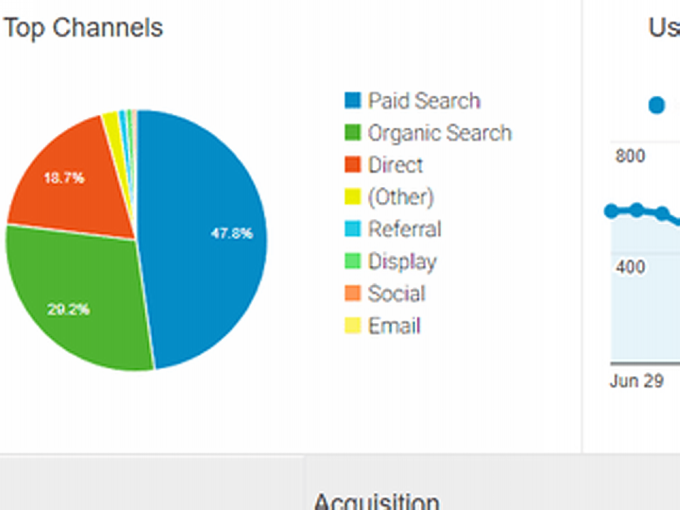There are numerous metrics in Google Analytics. The bounce charge is among the many most outstanding, however it’s additionally among the many most misunderstood. On this put up, I’ll deal with the bounce charge metric and supply steering in utilizing it.
Google Analytics consists of “Bounce Charge” in lots of reviews beneath “Viewers,” together with Viewers > Overview.
Google Analytics consists of “Bounce Charge” in lots of reviews beneath “Viewers,” together with Viewers > Overview.
—
Bounce Charge can also be reported within the “Acquisition” reviews.
Bounce Charge can also be reported within the “Acquisition” reviews.
Google Analytics data a bounce each time a person lands on a web page of a web site and exits the location with out further engagement hits. Sometimes, this implies the person doesn’t proceed to a different web page. However engagement hits may also be Occasions, Ecommerce Actions, and Ecommerce Transactions. All influence the bounce charge.
Analyzing Bounce Charge
I’m continuously requested, “What’s a suitable bounce charge?” On-line retailers ought to maintain the bounce charge as little as attainable for all visitors, particularly paid visitors. Bounce charges over 50 % usually equate to low conversion charges. However retailers ought to examine even a 30 % bounce charge, particularly, once more, for paid visitors.
There are exceptions.
Say a person lands on an ecommerce product web page and decides to buy the product. However she desires to name the service provider first. She could buy over the telephone, full the decision, and go away the location with out producing one other hit. Google Analytics would report this as a bounce. However it was a improbable session as a result of it resulted in a sale!
Time on Web page
If bounce charges are excessive on sure pages, take a look at “Avg. Time on Web page” to see how a lot time non-bounce guests spend. Separate pages which can be performing very poorly with excessive Bounce Charge and low Avg. Time on Web page (which point out fast exit from the pages) from pages which can be performing higher the place customers learn the content material. An affordable threshold for Avg. Time on Web page might be estimated by measuring how lengthy it takes to learn at the least half of the content material at a gradual tempo. If a fast quantity is required, something over 1 minute, on common, is sweet.
For correct Avg. Time on Web page metrics, create further engagement hits in Google Analytics, reminiscent of scrolling down the web page, clicking the play button on a video, or different Occasion. (There are directions for scroll monitoring on numerous web sites, together with the place it’s arrange in Google Tag Supervisor. Scroll monitoring ought to be rolled out on a reproduction Google Analytics view in order that the unique view doesn’t see a discount in bounce charges.)
The identical scroll monitoring may also be utilized to content material pages which have excessive bounce charges in order that the content material might be optimized to drive extra studying down the web page.
A low Avg. Time on Web page — computed precisely with using a number of engagement hits, reminiscent of scroll monitoring — can establish pages which can be performing poorly. Estimate an inexpensive threshold for Avg. Time on Web page by measuring how lengthy it takes to learn at the least half of the content material at a gradual tempo. For ecommerce websites, something over 1 minute, on common, is sweet in my expertise.
The technique for minimizing bounce charges and, due to this fact, growing time on web page differs amongst retailers. For poor performing pages (excessive bounce charge and low time on web page), enhance the content material and the calls to motion. For higher performers (excessive bounce charge and better time on web page), enhance the calls to motion.
Examples of pages with bounce charges over 50 % and common time on web page lower than 1 minute. Web page 10 on the listing has an Avg. Time on Web page of 1:44 (1 minute 44 seconds).
Conversion Charge
Examine ecommerce conversion charges with bounce charges for attainable correlations. To take action, go to Conduct > Web site Content material > Touchdown Pages to view each metrics.
Go to Conduct > Web site Content material > Touchdown Pages to check ecommerce conversion charges with bounce charges.
If each Bounce Charge and Ecommerce Conversion Charge are low, search for methods to optimize the content material and the calls to motion — or the worth proposition if relevant.
Some pages could have excessive bounce charges (over 50 %) however convert fairly properly (3-5 % or higher). On this case, there could also be alternatives to establish what non-converting guests are lacking within the web page content material or worth proposition, particularly if the touchdown web page is within the path to buy.
